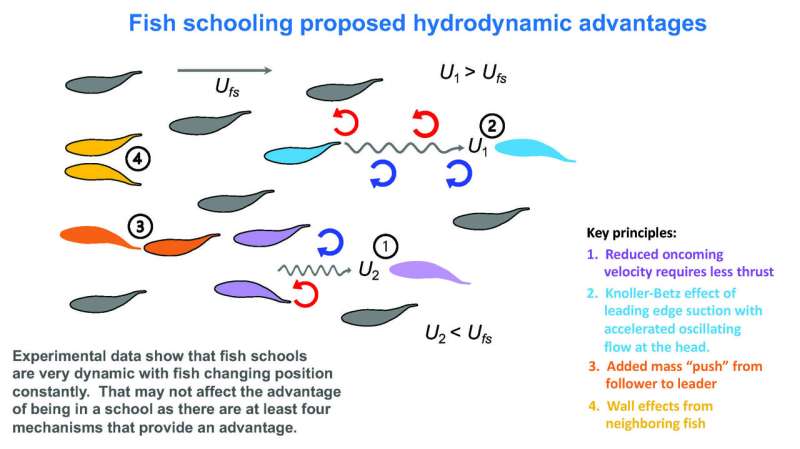Many animals, including apex predators, move in groups. We know this collective behavior is fundamental to the animal's ability to move in complex environments, but less is known about what drives the behavior because many factors underlie its evolution. Scientists wonder, though, if all these animals share a fundamental drive, such as for mating, safety, or perhaps even to save energy.
"The keyword is perhaps," said Yangfan Zhang, a postdoctoral researcher in the Department of Organismic and Evolutionary Biology (OEB) at Harvard, "because no one has actually measured this and compared it directly across all animal groups, mainly because it's difficult to have a system that can measure not just a group, but individuals in that group. But, we do know that, evolutionarily, there is some pressure to optimize for efficiency of energy use."
In a new study published in eLife, Zhang and co-author Professor George Lauder, also in OEB and Curator of Ichthyology in the Museum of Comparative Zoology, questioned if coordinated group movements by animals moving through a fluid could reduce the energy cost of locomotion.
By combining biomechanics and bioenergetics (measuring metabolic energy consumption and animal movement simultaneously in a highly specialized experimental platform), the researchers found not only a significant amount of energy conservation but also identified the reduced energy use per tail beat.
Terrestrial vertebrates evolved from fish, transitioning from fins to limbs and modifying respiratory organs from aquatic breathing to air. Despite different environments and breathing systems, all vertebrates and fish share the same metabolic pathways to produce energy. One pathway uses oxygen called aerobic metabolism. The other pathway, called anaerobic, is used when oxygen is limited or cannot supply sufficient energy to move at high speeds.
Combined, they contribute to the total energy expenditure of movement. Fish, however, have a greater need to optimize their locomotion than for animals moving in the air or on land. This is because water is 50 times more viscous a fluid than air and demands considerable energy to overcome fluid resistance during movement.
Water also contains five times less oxygen per kilogram compared to air; meaning aquatic animals are "squeezed" by a lower ceiling of oxygen availability and have a higher pressure on energetic demand.
To test the energy cost of locomotion in fish, Zhang and Lauder designed a sealed water "treadmill" that controlled water velocity. By measuring the rate at which oxygen is removed from the sealed "treadmill," the researchers were able to distinguish the rate of oxygen uptake by the animals.

"The system is designed to have the measuring sensitivity to capture the energetic cost of an individual fish compared directly to the cost for a group of eight fish," said Zhang. "By standardizing the biomass of the fish in the water treadmill with controlled water velocity, we can directly compare the cost of swimming between fish schools and an individual fish."
The "treadmill" also employed two high-speed orthogonal cameras to capture unique locomotion features—one from a side view, the other from the bottom. This helped to measure the three-dimensional positions of the fish and allowed the researchers to measure the distance between fish in the school.
"What we discovered is that the total cost for the group to move as a whole is much lower per biomass compared with an individual, and the group expended the least amount of energy at a median speed of one body length per second," Zhang said. "When we look at studies that track wild animals, we find that a lot of animals migrate at a speed of around one body length per second."
The researchers found that moving quickly required more energy, but so did moving slowly. However, at a medium speed of one body length per second, they saw a dip in the energetic curve where swimming was at a minimum cost, which increased at both faster and slower speeds presenting a J-shaped relationship.
As the most diverse vertebrate group, fish species have an immense cultural and commercial value to human society. Yet, changing climates are a direct challenge to the biodiversity of fish.
"Projections on the future abundance of fish species cannot be based only on the biology of the individuals," Lauder said, "we also need a fundamental understanding of collective movement that accounts for the interactions among the individuals within a group."
"Studying the energetics of aquatic locomotion under environmental constraints offers insight not only into highly conserved features of vertebrate physiology but also into the inner workings of fluid dynamics principles and animal locomotion."
"I think the beautiful thing about this study is that we captured the full spectrum of the energy expenditure in a holistic way that enabled us to account for an energy cost moving at high speeds," said Zhang. "Scientists have been looking at this question for decades, but we found that the key lay in measuring not just the aerobic but also the anaerobic costs. That is a huge part of any organism, and without measuring both, you get only half the story."

Explore our curated content, stay informed about groundbreaking innovations, and journey into the future of science and tech.
© ArinstarTechnology
Privacy Policy